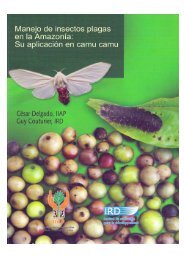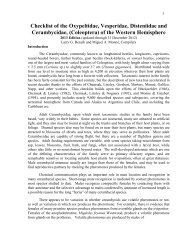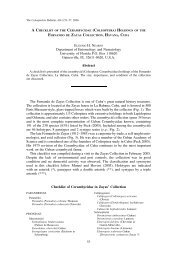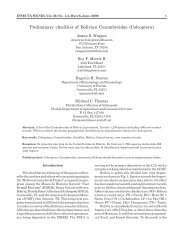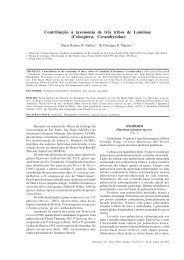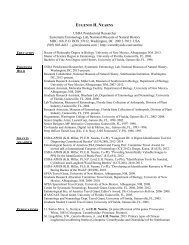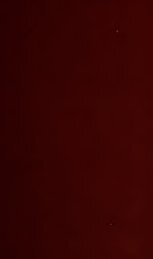You also want an ePaper? Increase the reach of your titles
YUMPU automatically turns print PDFs into web optimized ePapers that Google loves.
LAWRENCE S. DILLON <strong>AND</strong> ELIZABETH S. DILLON 127<br />
behind humeri narrowly brown to apical quarter. Body beneath dark reddish<br />
brown to fuscous, hoary-gray pubescent, irregularly fulvous maculate; mesosternal<br />
side-pieces traversed by a patch of fulvous or whitish tomentum, and usually with<br />
an irregular, brown vitta which extends posterio-Iaterally over the metasternum<br />
and the metepisterna ; abdomen more densely pubescent laterally with brighter ful<br />
vous, at least Oil third to -fifth sternites. Legs light to dark reddish-brown, thinly<br />
hoary pubescent; femora above tinged with fulvous; tarsal claw segment conc010r<br />
ous. Antennae testaceous to fuscous; proximal five segments dark brown pubescent,<br />
with a variable amount of fulvous-white intermingled, especially on bases of fourth<br />
and fifth; rest densely and entirely fulvous-white tomentose.<br />
Head above minutely punctate, a median line extending from occiput to epi<br />
stoma; front rather broadly concave between antennal tubercles, broad, subquad<br />
rate, minutely punctate, and with sparse, finc punctures scattered over entire sur<br />
face; genae vertical, with a few fine punctures; eye with lower lobe elongate-oblong,<br />
slightly exceeding gena in height; antennal tubercles very robust, strongly promi<br />
nent, on inner side at apex with a short, robust, upright horn, the tip of which is<br />
(lUrved laterally. Pronotum about one-fourth wider than long, sidcs parallel, almost<br />
straight, shallowly cmarginate near base, unarmed; apical and basal tran.sverse<br />
sulci narrow, the latter deep, joining the lateral oblique ones, which are broad and<br />
terminate suddenly at sides; disk basally with a small, oval tubercle at middle, each<br />
side cntirely occupicd by a fiattened tumid area, indistinctly obliquely impressed ;<br />
across base a band of sparse, fine punctures. Scutellum strongly transverse; sides<br />
straight, oblique; apex broadly truncatc, its margin strongly beveled. Elytra with<br />
sides straight, attenuate to apices, which am separately rounded; entire basal half<br />
rather coarsely, densely punctate, behind middle somewhat more finely so, along<br />
suture on apical half a finc, distinct, impressed line; humeri slightly prominent,<br />
anterior margin rounded, oblique, angle with a projccting tubercle. Prosternum<br />
narrow, unarmed, only slightly widened posteriorly. Procoxae globose, distinctly<br />
uncate before; femora very strongly clavate, profcmora robust, others succcssively<br />
morc slender and shorter, profemora on basal quarter transversely rugose anteriorly<br />
and posteriorly; tarsi robust, their three basal segments transverse. Fifth sternite<br />
subequal in length to fourth, apex broadly retusc. Antennac robust, onc and one<br />
half to nearly twice length of body, si}. 1:h segment attaining elytml apex; fimbriate<br />
,beneath on proximal five segments, densely so on first to third, sparsely on fourth<br />
and fifth; scape rather short., robust, slightly clavate apically, not rugose beneath;<br />
second segment elongate, distinctly longer than wide, at least one-fourth length of<br />
soape, slightly broadenedapic lly; third onc-half agaifi as long as first, feebly bi<br />
fiexuose, basal curve short, aplcal curve long and gradual; fourth and fifth succes<br />
sively shorter, rest subequal; eleventh distinctly longer than tenth, apex with a<br />
curved process.<br />
FEMALE. Very little different from male, but having antennal tubercles horned<br />
as in that sex; proeoxae not uncate, with a feeble tubercle anteriorly instead; pro<br />
femora not rugose; tarsi not robust, ·first segment slightly elongate, second and third<br />
subquadrate; fifth stcrnite one-fourth longer than fourth, apex deeply emarginate,<br />
with a feeble triangular impression; antennae one-half again as long as body, sev<br />
enth segment attaining elytral apex, scape more elongat.e, nearly attaining middle<br />
of pronotum, less robust; eleventh no longer than tenth, its apex simply tnpered.<br />
LENGTH 12-16.5 mm.; width 4.2-6 mm.



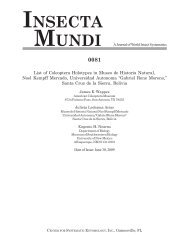
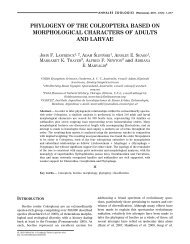


![Coleoptera. Vol. I. [Longicornia. Part I.]](https://img.yumpu.com/41202793/1/180x260/coleoptera-vol-i-longicornia-part-i.jpg?quality=85)
